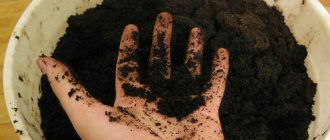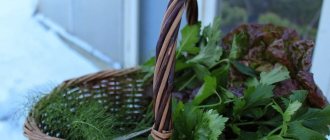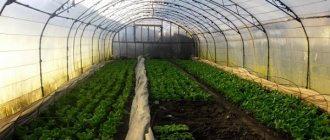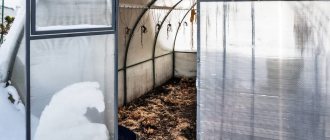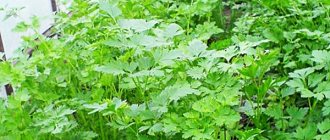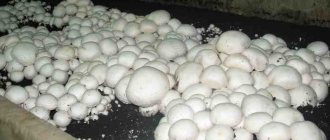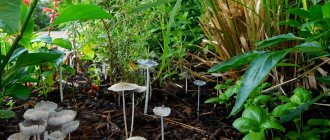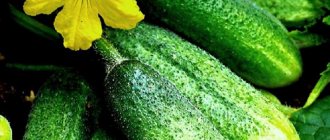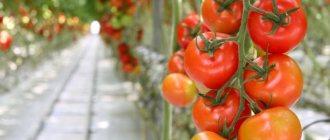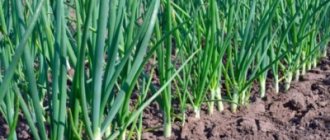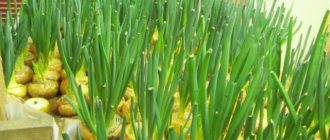Not so long ago, oyster mushrooms were a delicacy on the table of the average person, but now these mushrooms can be found at any time of the year, almost everywhere. Today, it has become an excellent alternative to champignons, both in price and quality, and in the ease of its cultivation.
Growing oyster mushrooms yourself is not as difficult as it seems. These mushrooms are quite unpretentious, do not require special care and are less susceptible to the harmful effects of pests than other varieties.
Oyster mushrooms can be grown in a greenhouse at any time of the year. All you need is a room, growing material and some free time to provide the mushrooms with proper care. Within a few weeks after planting, if everything is done correctly and the conditions are met, you will be able to enjoy your first harvest.
Is it possible to grow oyster mushrooms in a greenhouse with your own hands?
Growing oyster mushrooms in a greenhouse is not only possible, but also necessary. An indicator of high quality for these mushrooms is the absence of a stem, and such a result can only be obtained in the wild or in a greenhouse with natural light, and the coating material does not matter.
Did you know? Of all the mushrooms, oyster mushrooms are the most similar to meat in terms of nutritional content.
Cultivation is possible under the following conditions:
- natural light;
- lack of heat;
- high humidity;
- correct soil;
- access to fresh air.
How to grow porcini mushroom near your home
Mushroom pickers often pick overripe porcini mushrooms in the forest. Some people make their own liquid seed spore material from these mushrooms, and then water the ground with it in secluded places in their garden plot with suitable soil.
Mushrooms are chopped either using a knife or passing through a meat grinder. Mushroom mince is placed at the bottom of a trimmed 5-liter plastic bottle and filled with 4 liters of spring water at room temperature. Add 50 g of live baker's yeast, cover loosely with several layers of gauze and leave for 2 weeks in a warm, unlit place. 100 g of the resulting mixture is diluted with 2 liters of settled water and poured over the area. If the soil is not suitable, then it is prepared, bringing the composition as close as possible to the soil where the mushrooms were picked.
The first signs of mycelium growth will appear in a few months, and the first mushrooms will appear in a year and a half.
Advantages and disadvantages
- The advantages of growing oyster mushrooms in a greenhouse include:
- low costs;
- no need for expensive equipment;
- no need for a large area;
- protection from infection due to isolation;
- the ability to grow for sale;
- high profitability;
- simplicity of technology;
- confidence in the quality of the product;
- the opportunity to get organic mushrooms;
- the pleasure of eating homemade food;
- no need to license and certify your activities;
- the ability to involve family members in care;
- rapid growth of oyster mushrooms;
- a greenhouse will protect your respiratory tract from fungal spores, mold and humidity, unlike home cultivation;
- the possibility of saving space thanks to layered cultivation.
- The disadvantages include:
- the use of physical labor to care for mushrooms;
- dependence of the harvest on external factors;
- there is an opinion (unconfirmed) about the need to use respirators and protective clothing when working with mushrooms;
- fungal spores can cause allergies;
- A truly profitable business is possible if there is a market.
Also read about the technology of growing champignon mushrooms in a greenhouse.
How to properly grow mushrooms on a plot of land?
There are several ways to grow mushrooms both on the farm and in agricultural production: firstly, growing from spores, and secondly, from mycelium. On a personal plot, the first one is most often used.
Algorithm for growing mushrooms from spores
10-15 mushrooms are collected, the caps of which measure from 15 to 20 centimeters. The caps are separated from the legs. Mushroom caps are added to the water (150-200 grams per liter). 3-4 tablespoons of alcohol or sugar per 10 liters of water are added there (for more intense spore formation). Water with caps should be left in a warm room with high humidity for 24 hours. The hats are ground until smooth. The area around several trees selected for growing mushrooms (preferably birch, oak, pine or spruce) must be thoroughly loosened. Then remove the top (10-20 cm) layer of soil within a radius of up to half a meter around each tree so that the roots are clearly visible, while being careful not to damage them. The roots of the trees are watered with an infusion of spores, after which they are covered with removed soil. Water every few days
It is IMPORTANT not to change the amount of water and time intervals between waterings.
Nota bene: in southern latitudes, the time for planting porcini mushrooms is May-June, in northern and northwestern latitudes - August-September. They bear fruit in the second year.
Algorithm for growing mushrooms from mycelium
- Porcini mushroom mycelium is purchased.
- A planting area should be formed around the tree, removing the top layer of soil.
- Peat soil or special compost up to 5 centimeters thick is laid on the resulting area.
- Pieces of mycelium are laid out on the prepared area at a distance of up to 5-10 cm from each other.
- The mycelium is covered with a layer of soil removed from this area.
- The soil is watered with water at the rate of 20-30 liters per area around one tree.
- To maintain humidity, the area can be covered with a layer of straw up to 50 cm thick.
- Regular watering is carried out as the soil dries out.
- The area can be covered with moss or straw during the cold season.
Boletus mushrooms can also be grown in an apartment. Basic requirements for the room in which mushrooms will be grown:
- maintaining constant temperature and high humidity;
- ensuring the receipt of a strictly defined (small) amount of sunlight;
- planting strictly defined planting material, namely mycelium.
All this requires large investments and time, but is compensated by advantages: fertility all year round and high ripening speed. The mycelium purchased should not have an ammonia odor. Its presence indicates the non-viability of the planting material due to overheating. Healthy exudate is orange-yellow in color.
Algorithm for growing porcini mushrooms indoors
Planting material is carefully checked according to the above criteria. The bags with mycelium are ventilated. The contents of the packages are fragmented
It is IMPORTANT not to tear the packaging in order to maintain optimal temperature conditions. Separate rooms for growing mushrooms and laying mycelium should be prepared by treating them with a disinfectant. The substrate is boiled for 1-1.5 hours, then cools completely. The substrate and mycelium are mixed, and the mixture should contain 2.5 - 5% mycelium, depending on the quality of the planting material. The mixture is placed in bags and compacted. Cuts are made in the bags on one side for mushroom germination. The bags should be placed vertically on the shelves. Regular watering and ventilation of the room are carried out.. Nota bene: All work with mushrooms is carried out with gloves
Nota bene: All work with mushrooms is carried out with gloves.
The right time to plant seedlings in a greenhouse
The best time to plant oyster mushrooms in a greenhouse is late summer, but they can also be grown at other times of the year. Mushrooms can be planted all year round together with other crops (preferably with cucumbers) or during free time from growing other plants.
Many gardeners have their greenhouses idle in winter because vegetables require additional lighting and heating, which increases their cost, while for mushrooms these requirements are much lower. Good results are obtained by growing in a greenhouse during periods of high humidity (spring, autumn). The problem can arise in hot summers, because oyster mushrooms cannot tolerate high temperatures and stop their vital activity.
Basic requirements for a greenhouse
These mushrooms can be grown in a greenhouse for vegetables or in a specialized greenhouse for mushrooms.
The latter are of the following types:
- two-tier 4-flank St. Petersburg;
- Greek 7-flange model 1861;
- combined 4-flange Moscow gardeners.
- The following requirements apply to a greenhouse for growing oyster mushrooms:
- It should be warm, because mushrooms require stable heat to grow. You can insulate for the winter by installing a second shelter circuit.
- For growing in winter, additional heating is needed, optimally of the water type.
- It must be airtight so that drafts do not lead to sudden temperature changes.
- It is necessary to provide for the possibility of ventilation through vents or supply and exhaust ventilation (ventilation pipes).
- It should be possible to humidify the air by spraying water.
- It is necessary to provide protection from direct sunlight through the roof - install colored or translucent polycarbonate, make an additional contour from covering material, install curtains, whitewash the roof.
- To insulate the soil in winter, it is covered with foamed polyethylene with a metallized layer.
- To save space, you will need racks and shelves.
- There are no size requirements; it all depends on the scale of the planned sowing.
Important! The greenhouse where oyster mushrooms grow should not be heated with a gas burner, as this dries out the air.
Some nuances of growing champignons
Today, growing mushrooms in a greenhouse is a fairly popular and very profitable business today. And champignons are most suitable for this, since they are much more expensive than any other mushrooms.
Moreover, Moscow gardeners have developed their own technique for growing champignons: they build special combined 4-flange greenhouses with stove, gas or electric heating, and grow these mushrooms in them from September to February. And after the turnover ends, the free greenhouse area is used for forcing early vegetables.
Preparation of mycelium
So, the first thing you need to do is purchase mycelium and prepare special compost for it from horse manure (in extreme cases, cow manure) and straw. To do this, the straw is slightly moistened, and urea and superphosphate are added to it. This procedure must be repeated over several days. After that, manure must be placed in the finished pile, and straw on top of it. Exactly after 4 days, all this should be mixed well, adding plaster and water. And stir again several times, every four days. Once the compost has matured, the mycelium can be planted in it.
Features of growing oyster mushrooms at home
If you want to grow oyster mushrooms, you need to familiarize yourself with planting technology.
How to prepare seedlings
To plant oyster mushrooms, you need to buy mycelium. Before planting, it and the substrate are kept in the same room for a day so that both are at the same temperature.
As a substrate you can use:
- freshly cut stump;
- undried timber;
- a mixture of 45% cereal straw, the same amount of cabbage stalks, 6% wheat bran, the rest is filled with plaster or chalk;
- a mixture of 90% sunflower husks, 5% soy flour, gypsum or chalk;
- a mixture of hardwood sawdust and wood shavings (45% each) with 8% rye or wheat bran, gypsum or chalk;
- a mixture of 30% sawdust with 60% buckwheat husks and beer grains;
- a mixture of 85% wheat straw with 13% grass legume meal and chalk.
To protect the future harvest from mold, add 10 g of Fundazol or Benlat per 100 kg of substrate, and 2.5 g of Dimilin per 100 kg of substrate to protect against fungus flies and mosquitoes. All components of the substrate should not be larger than 5 cm.
The substrate is treated with hot water: mix all the components, put them in polypropylene bags, put them in a container with hot water and leave for 5 hours. Then the bags are taken out, laid down on a slope, placed under a load and allowed to drain. The procedure will be completed when no water comes out of the substrate squeezed in your hand.
The prepared substrate has the following characteristics:
- humidity - 70–80%;
- temperature - +25°C;
- structure - loose, crumbly.
Stumps and timber, if they are not freshly cut, can be soaked in water for a day.
Important! Oyster mushrooms do not grow on waste from coniferous trees.
Transplanting
If oyster mushrooms are grown in a substrate, then special bags will be required, the dimensions of which are 0.5 × 1 m. On each side of the bag, 12 slits with a diameter of 10 cm are made. A layer of the substrate, a little mycelium kneaded by hand, is poured into the bag, and the layers are repeated, carefully compacting each one. In total, 1 bag requires 300–450 g of mycelium. The tied bags are placed in the greenhouse at a distance of 0.5–0.6 m from each other.
When growing on stumps or bars, you need to drill about 8 holes in them from above (on the side where the tree grew) and the same number at the edges, diameter - about 2 cm. Mycelium is poured into the holes, compacted well, filled with garden varnish or covered with plasticine .
A hole 5 cm deep is dug in the ground, a stump is placed in it, sprinkled on the sides, and the soil around the stump is watered. Or you can dig a hole like this, pour sunflower husks and mycelium into the bottom, water it, put a stump on top, and lightly sprinkle it with soil. The distance between stumps is at least 35 cm.
Video: how to grow oyster mushrooms on stumps
How do you know when the humus is ready?
The color of the manure becomes dark brown, has a fine-grained structure, grass may be visible and there is no odor. These are four signs of ready-made humus.
After this, compact the resulting mixture to 20 centimeters.
Now it's time to start planting mushrooms. Place them in a checkerboard pattern 30 centimeters apart. When all the mushrooms are planted, add manure to them and compact them lightly.
After 15-20 days, as a rule, the mycelium takes root, and the soil is covered with earth to a thickness of 5 centimeters.
Rules of care
When caring for mushrooms, you need to remember about temperature, fresh air, watering and a substrate rich in necessary substances.
Temperature
Oyster mushrooms should grow at temperatures in the range of +23...+25°C. To stimulate growth, it is recommended that 2 weeks after planting, when the substrate turns white, turn off the heating and bring the temperature to +2...+4°C. After 2 days, the heating is turned on and the temperature is maintained at +15°C.
Low temperatures promote slow but high-quality growth of mushrooms. They become larger, with short legs. It is necessary to remember that these mushrooms need access to fresh air, and regularly ventilate the greenhouse.
Did you know? The largest number of oyster mushrooms grown in one place
—
473 pcs.
How to water
Watering is needed by drip; it is better to use rain or warm melt water. You can spray water manually or using special equipment. Air humidity should be maintained between 75–90%. Watering is not carried out at temperatures below +10°C. If mushrooms are planted on stumps or bars, then water the soil around them.
What to feed
For feeding, waste from the woodworking industry and agriculture is used:
- sawdust;
- wheat or rye bran;
- soy flour;
- herbal flour;
- beer grains;
- gypsum;
- chalk.
They are added to the substrate during planting.
Preparing the ground
To prepare before planting, be sure to prepare the soil. Be sure to chop the straw, husks and husks. After grinding, carry out heat treatment. This treatment will allow you to get rid of unwanted bugs, flies and harmful insects. To carry out heat treatment, take the substrate and place it in a large bowl, then cook it for two hours. After cooking, drain the water and cool it to room temperature. Do not under any circumstances allow the substrate to become waterlogged. To check the humidity, you will need to take a small amount of substrate into your fist and squeeze. If water flows from your fist, try squeezing the substrate harder.
A couple of drops or their complete absence is allowed.
Harvest and storage
The first harvest appears on the 27-30th day from planting or about a week after you notice the primordia - small tubercles. Use a sharp knife to cut off the oyster mushrooms and carefully collect all the remains of the legs. Not earlier than in a week, the mushrooms will grow again. In total, it will be possible to collect up to 4 harvests in 2 months.
Next, new mycelium is planted. The harvested crop is poured into a large wooden box 2 m high and transferred to a cold room for blast cooling, after which it is stored in a refrigerator.
So, you can grow oyster mushrooms in a greenhouse, and this process is not accompanied by any special difficulties, so even beginners can do it. By observing the requirements for the greenhouse and the conditions inside it, anyone can get their own harvest. This option is ideal for those whose greenhouse sits idle without load in winter.
Mycelium
Planting mycelium is grown in specialized farms. It is grown in 2-liter jars containing compost weighing 700 g. This material is enough to sow 1.5 square meters. m. mushroom ridge. The mycelium can be stored in the refrigerator for about a year.
A grain version of mycelium based on a mixture of rye and wheat is also produced. Mycelium is sold in plastic bags and supplied with instructions. Which material is better - opinions differ on the forums.
